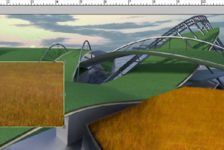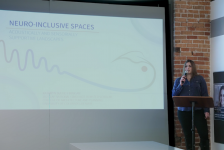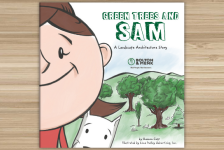Last week’s post on print portfolio resources was so much fun, and I have more stuff for you in the future….but as I mentioned, this week I have another “Interview with an Employer” to share with you and here it is. As I mentioned in the first “Interview” post, I have been asking colleagues for their perspective on resumes and portfolios. Each of them is in the position of doing the hiring and portfolio review for their respective firms. I encourage them to tell me what they feel is important without many specific questions to respond to. It is very interesting to see what comes up spontaneously, and I hope that these bits of advice give you something to consider in your own portfolio design process. I type my notes and send them to the Employer, then they approve or modify it, and I put the finished version up here for you. It is through this process, that as much as possible, these are their words.
I recently talked to Leslie Golden of Golden Associates Landscape Architecture (they do not have any open positions at this time). Leslie generously took time out of her crazy schedule to talk with me about portfolios. She showed me some samples of recently received materials and we talked about each of them, what was good, bad, (and worth the benefit of the doubt until she could see the person in an interview). Below is her input (with my comments in parenthesis):
Pdf’s:
- If you send me a pdf, bring a printed copy with you to the interview. Do not assume that I have printed it, and that my copy is adequate for the interview.
- When sending a pdf to someone, print it yourself and make sure that there are no differences between it and what you expected to see. (She then showed me a print-out with illegible labeling that somehow got scrambled in the process. We also saw a copy of someone’s work that she had printed from a pdf where some of the pages came out upside down, straight out of her duplex printer, and we had to keep flipping the pages over to be right side up.)
Format:
- If your samples of work are in landscape format, don’t send a resume in portrait format. These decisions should never be arbitrary.
- Always make sure that all your materials look like they belong together.
References:
- Make sure that your references are current and that all the contact information is correct. I have actually had someone give me two references with numbers that were not-in-service. Don’t make me do the work, calling outdated numbers – that is your job.
- The person being listed as a reference should know that I might call and that they have been listed as a reference.
- If you are going to leave a reference off, be prepared to explain why.
- If you don’t have any professional work experience, give me character references. Even something from your landlord or professor, letting me know that you are responsible, able to pay rent on time, complete work, etc. Volunteer somewhere and get me a reference from there! I understand that not everybody has had their first professional job yet, but I need to know that you will show up on time, behave like a professional, and a responsible person, regardless of the specific job.
Interviewing:
- You are interviewing the employer as much as they are interviewing you. Ask them questions, and make sure that you do your homework as well! I would not be offended if you asked me questions like “what is your layoff history?” or “Have you ever been unable to pay your employees on time?” (I have a list of these questions and others that will be posted in the future).
- Desperation isn’t pretty. I know that you want a job, but try to relax in the interview and be yourself. Being too nervous just makes everyone uncomfortable.
- Ask to talk to an employee, find out if that person is happy in their job, do they like the environment, boss, work, etc. Try to find out if this is a team that you want to join.
Q: “What do you need to see in someone’s materials to call them for an interview?”
A:
- Creative work. I want to see something I haven’t thought of before in the work itself.
- I want to see nice renderings, and the thinking behind the design. I need the whole package put together, start to finish. I need to know that the applicant can take a project from concept through construction documents and beyond. If you are not at that level – be ready to explain what qualities you do have and your desire to learn.
- I need to see a range of skills, hand-drawing, cad, SketchUp, Photo simulations etc.
- I also want to see at least one full detail sheet. The details should be lined up, organized, with appropriate line-weights.
- I need to know that this person has critical thinking skills.
Q: “I have been asked by some readers specific questions that are on their minds. For example, someone with a fine arts background wanted to know if it was okay to include some of that work as part of their portfolio. What do you think?”
A: “I am not interested in that unless it is related to Landscape Architecture.” (Ms. Golden has a very strong background in fine arts, she is not unsympathetic!)
Q: “So what advice would you give an entry level person who has a little free time and is looking for work?”
A:
- Read and study the Time Saver Standards! When I was an employee, I brought the Architectural Time Saver Standards to my review and told my boss that it was my night-time reading. Learn the detailing, become familiar with how things are built.
- Pay attention to your surroundings, like there in front of us is a curb, a tree grate (we were eating lunch at a cafe), traffic signs, and a sidewalk. Think about how those elements were built, try to figure it out, and imagine or draw the details for them. This is a GREAT way to learn!
- Have a game plan that shows motivation– work for two year and take your licensing exam – or study for LEED AP or BFL (Bay Friendly Landscaping Certification).
Q: “What is an automatic deal-breaker for you?”
A:
- Sloppy work, a GPA noted that is below 3.8. This is your chosen field, so if you weren’t able to keep your grades up in this major, don’t volunteer that information. However, you should be prepared to tell what your GPA was if you are asked. Honor students or awards should be highlighted.
- I need to see a beautiful presentation. It says something to me if you can’t layout your own portfolio.
- I also need to know that they understand that there is a hierarchy of information, what parts are more important, which pieces are less important. For example, on this portfolio (a pdf file printed by her on 8.5×11 paper), the design inspiration images are too small to make out, but that is okay, because they were just the inspiration behind this person’s work, not actually their design work.
- Don’t tell me about your obsession if it isn’t what my office does. I don’t need to see tons of examples of golf course design because that is not what my office does.
- Applicants should do their homework and be aware of what our office specializes in. Be prepared to tell me why you want to work here and what intrigues you about our work. What is your passion and what can you contribute.
Q: “So overall, what are you looking for?”
A:
- I am looking for someone with clarity of thought, who is organized, confident, and can communicate.
- I also need the right person for this office. I need to see skills that I can market or that will round out the skills we already have here.
- I need someone who can work as part of a team, is consistent and dedicated. It doesn’t do me any good to have lots of turnover and keep training new people, so I make hiring decisions very carefully, and it tells me something if you take the process as seriously as I do. Employment should be a mutually beneficial relationship.”
I would like to thank Ms. Golden for an enjoyable conversation and her generosity in sharing so much with me! More “Interview” posts are in process, but next time I will be addressing a question that came up from someone who has been following this series and inspired me to address what order your materials should go in. It is an interesting subject, and one that I am sure will evolve and change and be discussed for a good long time.
As always, please add your comments below or let me know what is on your mind – my goal is to make these posts as timely and useful as possible! Thanks!
Next week, we’ll chat about a few options for the order that you choose to put your materials in.
Published in Blog










